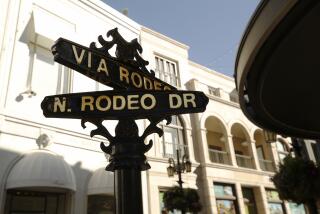Compared to Rents Charged on Fifth Avenue in N.Y., Retailers on Rodeo Drive Have a Bargain
NEW YORK — Manhattan’s fabled Fifth Avenue is still the golden way for merchants, and they pay the highest commercial rents in America to stay there, according to a new real estate survey.
And three other New York shopping districts are among the eight most expensive places in the country for specialty, non-department store businesses. Rodeo Drive in Beverly Hills is No. 4. Fashionable streets in Chicago, Palm Beach, Fla., and Washington were also on the list.
“Every major designer and major foreign manufacturer would love a presence on Fifth Avenue. There are rumors Christian Dior is looking to open a store there,” said Michael Hirschfeld, chairman of Hirschfeld Cos., a New York-based real estate firm specializing in the retail market.
Hirschfeld’s firm said the merchants who pay the most were on Fifth Avenue between 49th and 58th Streets. Such posh establishments as Tiffany & Co., Gucci Shops Inc. and Cartier Inc. pay anywhere from $300 to $425 per square foot in rent annually.
Two other areas in Manhattan came in second and third. On East 57th Street between Fifth and Lexington avenues, retailers pay between $250 and $375 per square foot, and on Madison Avenue between 61st and 72nd streets, the rent is $200 to $300 per square foot.
“This is the second year in a row Fifth Avenue and East 57th Street finished No. 1 and 2,” Hirschfeld said.
On Rodeo Drive, the Beverly Hills address for Gucci, Cartier and others, retailers pay between $150 and $200 per square foot, according to the study.
North Michigan Avenue in Chicago, where retailers pay between $125 and $175, is No. 5 on the list. Ranking sixth is Worth Avenue in Palm Beach, Fla., at $100 to $150. No. 7 is Columbus Avenue in New York, between 77th and 81st Streets, at an average of $133. Connecticut Avenue in Washington is eighth at $75 to $100.
More to Read
Inside the business of entertainment
The Wide Shot brings you news, analysis and insights on everything from streaming wars to production — and what it all means for the future.
You may occasionally receive promotional content from the Los Angeles Times.










